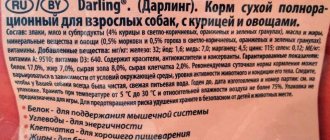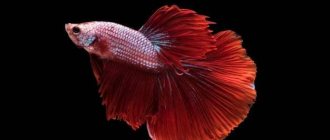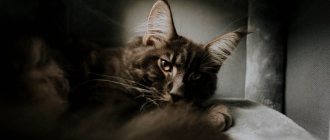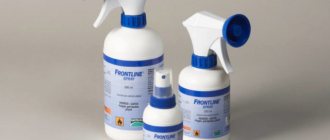A cute inhabitant of the warm waters of South Asia, the Lalius immediately attracted the attention of aquarists and quickly gained popularity.
This unpretentious fish does not require large volumes of water, behaves peacefully and has a bright appearance.
How to care for your lalius, who can you share it with, and how to protect your striped beauty from disease?
Habitat in nature
The first reports of the discovery of a new species of river inhabitants appeared in the 30s of the 19th century. Bright flocks of lalius were spotted in the waters of South Asia, in India, Pakistan and Bangladesh.
Assumptions that they can be found in similar climatic conditions of Myanmar and Nepal have not been confirmed.
The fish began to be exported to other countries, and today they successfully live in small rivers and streams of Singapore, Colombia, and the southern regions of the United States .
Lyalius prefer shallow reservoirs with abundant vegetation. Initially, the new breed of fish was called Colisa lalia, but in the modern classification it was renamed Trichogaster lalius.
How to choose?
Choosing a lalius in a pet store is associated, first of all, with the problem of purchasing a healthy fish without pathologies, parasites and diseases. The main rule here is the choice of young individuals. Do not be seduced by the beauty of a large male - most likely, this fish will live no more than 1 year. And if you take a young lalius, he will be able to please his owners for 2-5 years, depending on the conditions of detention.
In addition, large fish may not produce offspring, and if breeding is planned, this should also be taken into account.
When choosing a place to buy lalius, it is better to give preference to a pet store that has the necessary certificates and clear justification for the origin of the live product. Do not fall for tempting advertisements for selling pets with direct deliveries from Indonesia or India. Such fish can be infected with parasites; adding an exotic lalius that has not passed quarantine into a community aquarium is especially dangerous.
It is worth paying attention to the appearance of the fish. Peeling scales, cloudy eyes, torn or whitish fins are a reason to refuse to purchase an individual. But there is no need to worry about the fish being slow or gasping for air. This behavior is quite typical for Lalius.
Description
The photo of the fish shows that its body is compressed on the sides and beautifully framed by rounded fins running along its entire length.
Directly under the gills there are thin threads called fins, which serve to palpate surrounding objects.
The length of males is 7–7.5 cm, females are smaller, about 6 cm. The color of most species is striped, consisting of two or three colors. Males are brighter than females. The lifespan of fish is 4 years .
Other colors of lalius
- Red (bright red body, bright blue dorsal fin)
- Cobalt (uniform turquoise color)
- Green (blue-green color of the whole body)
- Red neon (red shiny body color)
- Iridescent (irridescent red-violet tones)
All color morphs belong to the same species and are easily crossed with each other, but it is better not to make such crosses, but to breed pure lines of Lalius, because offspring from crossbreeds are significantly worse in color than the original forms.
Varieties
Approximately the same in size and conditions of detention, the types of lalius are divided according to their color characteristics. We present popular types, descriptions and photos.
Neon
Lalius neon is a typical representative of the species with an unexpected coloration for the name: its body shines with a red flame , for which the fish is mistakenly called Lalius red.
The real red lalius is completely colored in the prevailing color, while in the neon species the red tone is originally diluted with a blue dorsal fin and bluish scales on the gills.
Peaceful in nature, neon loves dense greenery where it hides from trouble.
Rainbow
Along the body of the rainbow lalius are transverse stripes of blue and red. They are located diagonally so that towards the back they almost merge into a red tone, and along the bottom of the abdomen they become completely blue.
Interesting! When the lighting changes, the red color turns orange, and the delicate blue transforms into a deep blue.
Cobalt
The cobalt species is the result of long selection. The fish has a pronounced blue color with almost imperceptible stripes . This lalius is slightly smaller in size than other species; its body length does not exceed 6 cm.
Lalius blue is similar to the cobalt variety, but its body color is more delicate and not so bright. Rarely found on sale.
Yellow nano
A small fish (up to 4 cm) with a juicy yellow body color. Looks impressive when kept in nano-aquariums. Easy to care for and has a friendly disposition.
Coral
It is enough to look at the coral variety of fish to be convinced that the lalius is striped. This species has many stripes, which are colored in both red-orange and yellow-blue shades .
They run throughout the body from the back to the abdomen, forming a bizarre pattern. And its fins are also striped with bluish dots.
Blue dwarf
The blue base of the fish's body is brightly colored with red and blue-green transverse stripes. A spectacular addition to the main color is the red edging of the caudal and dorsal fins.
The dwarf lalius is similar in appearance to the gourami, but unlike the latter, its scales are completely blue and not spotted .
Compatible fish species
Due to their peaceful nature, Lalius get along well with calm phenotypes, but are vulnerable to aggressive species.
| Compatible | Limited | Incompatible |
| Cherry barbs | Bocia | Astronotuses |
| Guppy | Gourami | Akary |
| Danio | Discus | African cichlid |
| Corridoras | Cardinal | Barbus |
| sword bearer | Congo | gold fish |
| Minor | Labeo | Koi |
| Mollies | Macropod fish | Red parrot |
| Neon | Cockerel | Nothobranchius |
| Pecilia | Parrot | Piranhas |
| Rainbow | Ternetia | South American cichlids |
| Rasbora | Acne | |
| Angelfish | Chromis | Cichlazomas |
Lalius also demonstrates compatibility with adult gastropods. In addition, snails are considered the orderlies of the aquarium and will pick up the remains of uneaten food after the fish.
Snails will pick up leftover food from fish
Difficulties of content
Keeping and caring for lalius requires experience and patience. Fish are shy by nature, do not display good health, and are susceptible to stress. The aquarium should be installed in a place where they will be calm and quiet.
Any loud sounds can frighten the Lalius ; they will experience constant nervous tension, which will significantly shorten their lifespan.
Despite their small size, one pair of laliuses requires a tank with a minimum volume of 40 liters. The main parameters look like this:
- water temperature - 22...27 °C;
- acidity - 6.5–7 pH;
- hardness - 5–20 dH.
The aquarium should be equipped with a good filter, but without a strong current. There is no special need for an aerator, since Lalius belong to the labyrinthine family and can take air directly from the atmosphere .
Important! Do not plant floating plant species in an aquarium with lalius so that they do not cover the surface of the reservoir and the fish can freely take in air.
For the comfort of your pets, it is necessary to plant one of the corners of the aquarium with dense underwater plants. As a substrate , you should take river sand or dark-colored pebbles - against such a background, the color of the fish will look brighter.
Diseases
When buying fish, pay attention to the individuals and ask about their origin. At one time, there was a boom in the import of unhealthy individuals from Singapore, so quite a lot of carriers of dwarf iridovirus were imported - this disease is incurable. Therefore, do not buy apathetic aquarium fish.
Based on some signs in fish, popular diseases of lalius can be identified. For example, darkening of the color and redness of the pectoral fins is a sign of furunculosis. But if crumbling scales and an enlargement of the abdomen appear - pseudomonosis.
If the lalius is overtaken by diseases, they are treated by raising the temperature of the water, as well as with special solutions that can be purchased at a pet store. Remember that the main protection against disease is simply caring for your aquarium (cleaning the aquarium, aeration, water purity and temperature).
CHOCOLATE GOURAMI DESCRIPTION BREEDING FEEDING COMPATIBILITY PHOTO CONTENTS.
MOON GOURAMI DESCRIPTION CONTENTS BREEDING COMPATIBILITY PHOTO FEEDING.
GRUMMING GOURAMI CONTENTS COMPATIBILITY BREEDING DESCRIPTION FEEDING PHOTO.
Feeding
In the wild, laliuses feed on insect larvae and plankton. They also obtain food by knocking down insects with a stream of water released from their mouth. They dilute protein foods with succulent plant leaves.
for domestic laliuses , which can be purchased at any pet store .
They are fully balanced in microelements and have a fine fraction, which is important for fish with a small mouth opening.
Feed the Lalius once a day and do not forget about fasting days.
Interesting! Do you want your pets' color to be brighter? Introduce Tetra Rubin cereal into their diet.
External characteristics
Lyalius has a large body with brightly colored scales. The body shape is oval, elongated, flattened laterally. The dorsal and anal fins extend along the entire body. The pelvic fins look like whiskers due to very long thin rays. The fish uses them to feel the bottom. The tail is standard, medium in size, harmoniously complements the outline of the body. Lyalius has in its arsenal a labyrinthine organ that allows it to breathe atmospheric air. To do this, the fish rises to the surface of the water and swallows the bubble. In nature, the lalius obtains food with the same organ: it shoots a stream of water at insects flying over the water. In an aquarium, the fish does not use this skill, since there is no need to hunt.
Compatibility and Behavior
Lalius have good compatibility with the same peaceful and inactive fish species. The following would suit them as quiet neighbors:
- gourami;
- angelfish;
- labeo;
- iris.
Scandalous cichlids, barbs and other types of predators are not suitable for living together with laliuses . The inevitable fights in such a situation will lead to the death of more peaceful pets.
If you keep a species aquarium in which only laliuses live, select their number so that there are always more females than males . In addition, for females you need to install shelters and plant dense plants.
What else to pay attention to
Wild specimens have innate qualities to survive in difficult natural conditions. Aquarium representatives partially lose such abilities and need an environment favorable to the species. In addition, the artificially limited habitat of rainbow fish requires the breeder to correctly select the intraspecific composition for one aquarium.
Group content
Colises are gregarious inhabitants of tropical waters. In an aquarium they feel better in a group of 6-10 individuals. Single or pair housing is uncomfortable for lalius due to the sensitivity of the phenotype.
Colises feel better in a group of 6-10 individuals
Sex composition
With puberty, males begin to display territorial aggression towards their own kind. In nature or in spacious aquariums, such local problems, as a rule, are solved quickly - the weak individual swims away to a safe distance. In other situations, peaceful coexistence in a group of Lalius is achieved due to the superiority of the number of females over males, the so-called “harem” keeping.
From an aesthetic point of view, the male individual is of the greatest interest due to its beautiful and bright color. But a quiet life in the biotope will be achieved if there are 2-3 or more females per adult male. This gender composition will help reduce the likelihood of conflict situations, and the number of females is limited only by the volume of the aquarium.
Comfortable conditions
Cautious dwarf threadworts do not tolerate fuss and aggression in their environment. Therefore, these fish can only be kept with peace-loving neighbors and with a sufficient number of places where the lalius could hide.
Since the species occupies predominantly the upper layers, waterfowl plants must be placed in the aquarium. Lalius are biologically tied to this type of aquaculture.
Waterfowl plants must be placed in the aquarium
If there are a large number of plants and a minimum number of fish, the aquarium may not be equipped with a filter. It creates an undercurrent that rainbow threaders do not like.
Individual character
A predisposition to anxiety and a sense of vulnerability plunges Lalius into stress. And this has an extremely negative effect on the general condition of the fish and significantly reduces their immunity.
Reproduction and breeding
Readiness to produce offspring occurs at 7 months. The fact that the pair has formed can be seen from the behavior of the male: he is actively engaged in building a nest and chasing the female.
For successful spawning, the pair must be transferred to a separate container . Parameters for the spawner:
- volume - 20–30 liters;
- water column height - 10–15 cm;
- water temperature - 26...28 °C;
- hardness - no more than 4–6 dH.
The spawning tank is equipped with round-the-clock lighting. A few floating plants (riccia or duckweed) are placed on the surface of the water - the male will need them to build a nest.
Spawning lasts up to 6 hours, during which the female can spawn up to 600 eggs . During the spawning process, the male fertilizes the eggs.
After the female “gives up” all the eggs, they are removed. The male is in charge of the nest. After 3-4 days it should also be removed from the spawning tank, otherwise it will eat the fry.
The fry are fed with special dry food or chopped live food.
Reviews
I've been dreaming about lalius for a long time, and then I accidentally saw these striped beauties in a pet store. I already had guppies, a female swordtail and rasboras in my aquarium. I bought one male lalius. The fish lived peacefully and did not offend anyone. Unfortunately, he died when they forgot to close the lid of the aquarium. They didn't think he would jump out of the water. Angelina Mezentseva, 32, Kurgan
I keep lalius with angelfish, mollies and guppies. I must say that these are the calmest pets. They love privacy, fortunately I have a lot of plants in my aquarium. I feed dry and live food, but I noticed that the color becomes brighter after live food. Nikolai Petrovich
I love lalius. Colorful, with shining stripes, they look simply luxurious. They are easy to care for, you can save on a compressor and not listen to the whirring of the aerator all day long. MMarina_L











